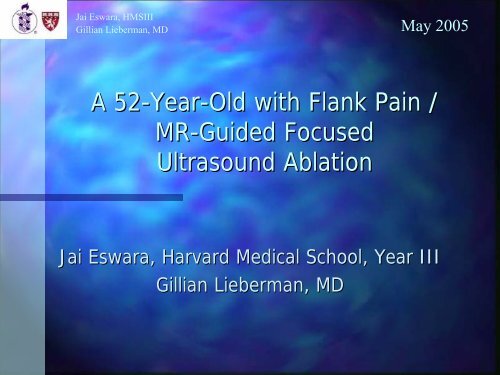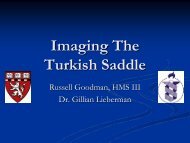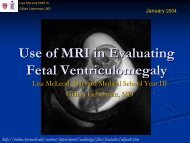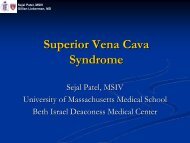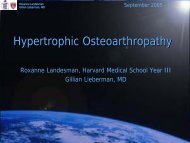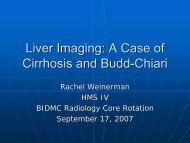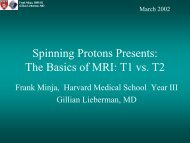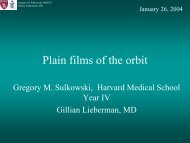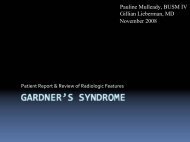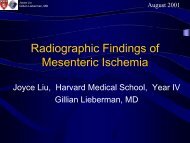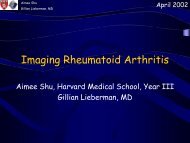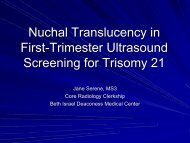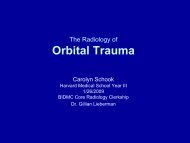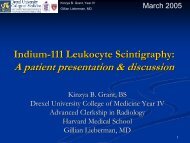A52-Year-Old with Renal Mass / MR-Guided Focused Ultrasound
A52-Year-Old with Renal Mass / MR-Guided Focused Ultrasound
A52-Year-Old with Renal Mass / MR-Guided Focused Ultrasound
You also want an ePaper? Increase the reach of your titles
YUMPU automatically turns print PDFs into web optimized ePapers that Google loves.
Jai Eswara, HMSIII<br />
Gillian Lieberman, MD<br />
A 52-<strong>Year</strong> 52 <strong>Year</strong>-<strong>Old</strong> <strong>Old</strong> <strong>with</strong> Flank Pain /<br />
<strong>MR</strong>-<strong>Guided</strong> <strong>MR</strong> <strong>Guided</strong> <strong>Focused</strong><br />
<strong>Ultrasound</strong> Ablation<br />
May 2005<br />
Jai Eswara, Eswara,<br />
Harvard Medical School, <strong>Year</strong> III<br />
Gillian Lieberman, MD
Jai Eswara, HMSIII<br />
Gillian Lieberman, MD<br />
Agenda Agenda<br />
Patient Presentation<br />
Differential Diagnosis<br />
Anatomy<br />
Discussion<br />
<strong>MR</strong>-<strong>Guided</strong> <strong>MR</strong> <strong>Guided</strong> <strong>Focused</strong> <strong>Ultrasound</strong> Ablative<br />
Therapy<br />
2
Jai Eswara, HMSIII<br />
Gillian Lieberman, MD<br />
Patient Presentation<br />
J.F. is a 52-year 52 year-old old man <strong>with</strong> acute<br />
onset of right flank pain after moving<br />
heavy furniture<br />
heavy furniture<br />
No CVAT<br />
Rectal exam benign<br />
Normal urinalysis<br />
Guaiac negative<br />
3
Jai Eswara, HMSIII<br />
Gillian Lieberman, MD<br />
Differential Diagnosis<br />
<strong>Renal</strong>/vascular<br />
Abscess/pyelonephritis<br />
Abscess/ pyelonephritis<br />
Infarction<br />
Thrombosis<br />
Nephrolithiasis<br />
Tumor<br />
Aorta<br />
AAA<br />
Radicular/musculoskeletal<br />
Radicular/musculoskeletal<br />
A A CT CT Urogram Urogram was was ordered…<br />
ordered…<br />
4
Jai Eswara, HMSIII<br />
Gillian Lieberman, MD<br />
Low-dose CT Urogram w/o IV contrast<br />
PACS, BIDMC<br />
5
Subcapsular<br />
hematoma<br />
Jai Eswara, HMSIII<br />
Gillian Lieberman, MD<br />
PACS, BIDMC<br />
CT Urogram w/ IV contrast<br />
6
Jai Eswara, HMSIII<br />
Gillian Lieberman, MD<br />
Differential Diagnosis after CT<br />
Angiomyolipoma<br />
<strong>Renal</strong> Cell Carcinoma<br />
7
Jai Eswara, HMSIII<br />
Gillian Lieberman, MD<br />
Hamartoma<br />
muscle, vasc, fat<br />
<strong>Renal</strong> Angiomyolipoma<br />
http://www.e-radiography.net/radpath/h/haematuria.htm<br />
8
Jai Eswara, HMSIII<br />
Gillian Lieberman, MD<br />
No fat visible<br />
in mass<br />
PACS, BIDMC<br />
CT w/ IV contrast<br />
9
Jai Eswara, HMSIII<br />
Gillian Lieberman, MD<br />
No fat visible<br />
in mass<br />
PACS, BIDMC<br />
T1-Weighted Axial <strong>MR</strong><br />
10
Hematoma<br />
beginning to<br />
organize<br />
Jai Eswara, HMSIII<br />
Gillian Lieberman, MD<br />
PACS, BIDMC<br />
Coronal SSFSE/HASTE <strong>MR</strong><br />
11
Jai Eswara, HMSIII<br />
Gillian Lieberman, MD<br />
PACS, BIDMC<br />
Sagittal LAVA <strong>MR</strong><br />
Midpolar mass -<br />
Indication for radical<br />
nephrectomy<br />
Identified on<br />
pathology as a<br />
papillary RCC<br />
12
Jai Eswara, HMSIII<br />
Gillian Lieberman, MD<br />
<strong>Renal</strong> <strong>Renal</strong> Anatomy<br />
http://www.enh.org/healthandwellness/clinicalservices/urology/index.asp<br />
13
Jai Eswara, HMSIII<br />
Gillian Lieberman, MD<br />
Types of <strong>Renal</strong> Cell Carcinoma<br />
Clear cell (80%)<br />
Papillary (15%)<br />
Chromophobic (5%)<br />
14
Jai Eswara, HMSIII<br />
Gillian Lieberman, MD<br />
Staging Staging <strong>Renal</strong> <strong>Renal</strong> Cell Cell Carcinoma<br />
TNM classification<br />
T1 - mass < 7cm<br />
T2 - mass > 7cm<br />
T3 - mass extends into major veins, fat,<br />
or adrenal gland<br />
T4 - mass extends beyond Gerota’s fascia<br />
15
Jai Eswara, HMSIII<br />
Gillian Lieberman, MD<br />
Spontaneous Rupture of Papillary RCC<br />
Extensive necrosis in tumor leads to rupture<br />
Necrosis can appear cystic on CT or U/S<br />
pRCC’s are FRAGILE!<br />
Approximately 10% may rupture<br />
Hora M, Hes O, Klecka J, Boudova L, Chudacek Z, Kreuzberg B, Michal M.<br />
Rupture of papillary renal cell carcinoma. Scand J Urol Nephrol. 2004;38(6):481-4.<br />
16
Jai Eswara, HMSIII<br />
Gillian Lieberman, MD<br />
<strong>MR</strong>--<strong>Guided</strong> <strong>MR</strong> <strong>Guided</strong> <strong>Focused</strong> <strong>Focused</strong><br />
<strong>Ultrasound</strong><br />
17
Jai Eswara, HMSIII<br />
Gillian Lieberman, MD<br />
Focusing <strong>Ultrasound</strong> Waves<br />
http://www.advanced-surgical.com/Documents/Science_and_Medicine/<br />
<strong>Ultrasound</strong> beams<br />
may be focused by<br />
curving the<br />
piezoelectric plate or<br />
by interposing a lens<br />
or reflector between a<br />
flat plate and the<br />
target. A phased array<br />
of transducers is<br />
focused electronically.<br />
18
Jai Eswara, HMSIII<br />
Gillian Lieberman, MD<br />
How How does does focused focused U/S U/S destroy destroy tissue? tissue?<br />
As waves interact <strong>with</strong> tissue, they<br />
transfer energy<br />
U/S causes gas bubbles to form<br />
<strong>with</strong>in tissue<br />
Collapse of the gas bubbles transfers<br />
heat to nearby tissue (“cavitation<br />
(“ cavitation”) ”)<br />
http://www.advanced-surgical.com/Documents/Science_and_Medicine/<br />
19
Jai Eswara, HMSIII<br />
Gillian Lieberman, MD<br />
Thermal Ablation of Tissue<br />
http://www.advanced-surgical.com/Documents/Science_and_Medicine/<br />
Protein coagulation<br />
and consequent tissue<br />
damage result from a<br />
combination of<br />
temperature elevation<br />
and exposure duration.<br />
The graph shows the<br />
relationship between<br />
these factors.<br />
20
Jai Eswara, HMSIII<br />
Gillian Lieberman, MD<br />
<strong>MR</strong>I Planning/Monitoring of Thermal Ablation<br />
http://splweb.bwh.harvard.edu:8000/pages/projects/fus/index.html<br />
21
Jai Eswara, HMSIII<br />
Gillian Lieberman, MD<br />
Advantages of of <strong>MR</strong>GFUS<br />
Noninvasive<br />
No ionizing radiation<br />
Fast energy delivery<br />
<strong>MR</strong> is temperature-sensitive: temperature sensitive: T1, diffusion coefficient,<br />
proton resonant frequency<br />
Thermal quantification<br />
Target can be as small as 2 mm in diameter<br />
http://splweb.bwh.harvard.edu:8000/pages/projects/fus/mrfus.htm<br />
22
Jai Eswara, HMSIII<br />
Gillian Lieberman, MD<br />
Disadvantages of of <strong>MR</strong>GFUS<br />
U/S is blocked by ___ & ___<br />
23
Jai Eswara, HMSIII<br />
Gillian Lieberman, MD<br />
Disadvantages of of <strong>MR</strong>GFUS<br />
U/S is blocked by air & bone<br />
slow<br />
24
Jai Eswara, HMSIII<br />
Gillian Lieberman, MD<br />
<strong>MR</strong> Detection of Thermal Changes<br />
http://www.advanced-surgical.com/Documents/Science_and_Medicine/<br />
A temperature-<br />
sensitive magnetic<br />
resonance image<br />
along the<br />
transducer axis<br />
shows focal<br />
temperature<br />
elevation (arrow)<br />
induced by an<br />
ultrasound pulse in<br />
rabbit thigh muscle<br />
in vivo. The scale is<br />
in centimeters.<br />
25
Jai Eswara, HMSIII<br />
Gillian Lieberman, MD<br />
<strong>MR</strong> Detection of Thermal Changes in Tissue<br />
http://splweb.bwh.harvard.edu:8000/pages/projects/fus/index.html<br />
26
Jai Eswara, HMSIII<br />
Gillian Lieberman, MD<br />
Post-Mortem Post Mortem Rabbit Kidney After FUS<br />
http://www.advanced-surgical.com/Documents/Science_and_Medicine/<br />
27
Jai Eswara, HMSIII<br />
Gillian Lieberman, MD<br />
The Future of <strong>MR</strong>GFUS<br />
Improvement in speed<br />
Optimizing <strong>MR</strong>I parameters<br />
Developing <strong>MR</strong>I-compatible <strong>MR</strong>I compatible devices<br />
28
Jai Eswara, HMSIII<br />
Gillian Lieberman, MD<br />
References<br />
1. Curti BD. <strong>Renal</strong> cell carcinoma. JAMA 2004; 292: 97-100.<br />
2. <strong>Focused</strong> ultrasound Laboratory.Brigham & Women’s Hospital / Harvard Medical School. 2003. Online.<br />
Internet.2005. http://splweb.bwh.harvard.edu:8000/pages/projects/fus/index.html.<br />
3. Hora M, Hes O, Klecka J, Boudova L, Chudacek Z, Kreuzberg B, Michal M.<br />
Rupture of papillary renal cell carcinoma. Scand J Urol Nephrol. 2004;38(6):481-4.<br />
4. Hynynen K. <strong>Focused</strong> ultrasound surgery guided by <strong>MR</strong>I. Science & Medicine 1996. Online. Internet.<br />
2005. .<br />
5. Kennedy JE, High-intensity focused ultrasound in the treatment of solid tumours. Nat Rev Canc<br />
2005; 5: 321-327.<br />
6. Shvarts O, Lam JS, Kim HL, Belldegrun AS. Staging of renal cell carcinoma: current concepts.<br />
BJU Int. 2005 Mar;95 Suppl 2:8-13.<br />
7. Wu F, Wang Z, Chen W-Z, Bai J, Zhu H, Qiao T-Y. Preliminary experience using high intensity<br />
focused ultrasound for the treatment of patients <strong>with</strong> advanced renal malignancy. J Urol 2003;<br />
170:2237-2240.<br />
8. Yoshimitsu K, et al. <strong>MR</strong> imaging of renal cell carcinoma: It’s role in determining cell type.<br />
Radiation Medicine 2004; 22: 371-376.<br />
29
Jai Eswara, HMSIII<br />
Gillian Lieberman, MD<br />
Acknowledgements<br />
•Jason Handwerker, MD<br />
•Gillian Lieberman, MD<br />
•Larry Barbaras<br />
• Pamela Lepkowski<br />
30


